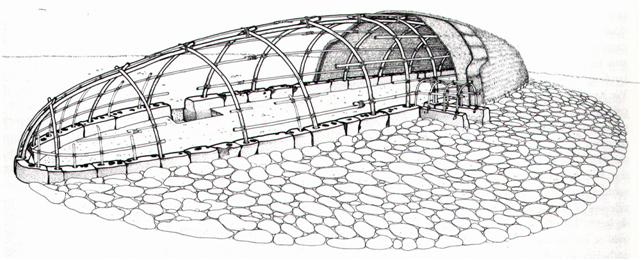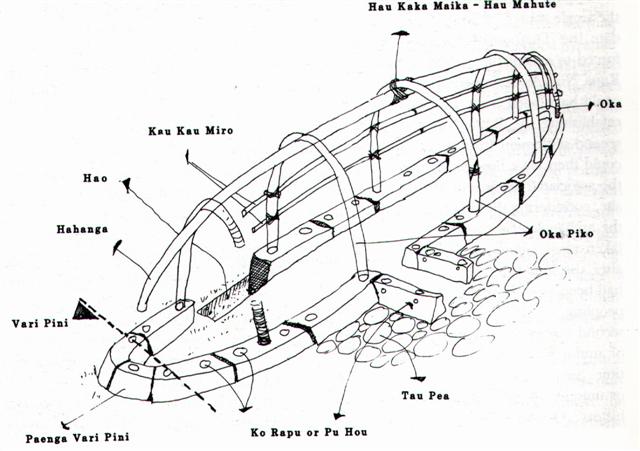Once again. The cosmic shape like an overturned boat was also in the hare paega houses of Easter Island:  Although used for living purposes it basically was a model of the night sky above. Sleeping inside this female form was like waiting for rebirth in the morning when the Sun would rise again. ... The most vivid description of hut interiors is given by Eyraud ... who slept in them several nights: Imagine a half open mussel, resting on the edge of its valves and you will have an idea of the form of that cabin. Some sticks covered with straw form its frame and roof. An oven-like opening allows its inhabitants to go inside as well as the visitors who have to creep not only on all fours but on their stomachs. This indicates the center of the building and lets enter enough light to see when you have been inside for a while. You have no idea how many Kanacs may find shelter under that thatch roof. It is rather hot inside, if you make abstraction of the little disagreements caused by the deficient cleanliness of the natives and the community of goods which inevitably introduces itself ... But by night time, when you do not find other refuge, you are forced to do as others do. Then everybody takes his place, the position being indicated to each by the nature of the spot. The door, being in the center, determines an axis which divides the hut into two equal parts. The heads, facing each other on each side of that axis, allow enough room between them to let pass those who enter or go out. So they lie breadthwise, as commodiously as possible, and try to sleep ... (Alfred Métraux, Ethnology of Easter Island.) The cosmic model is mentioned by Van Tilburg:
But once upon a time, when the creation of the 'day' had been completed there was a later dynamic phase beginning, in which even the stars in the 'night' were observed to rise in the east and descend in the west. The ancient Babylonian view could be used for understanding also the complementary nighttime flow from east to west - which probably was the origin of the model:  Jensen's Babylonian cross-section above is like that across a hare paega, where its door could be oriented to the east and the quartet of oka piko supporters would go from the east over the sky meridian, and then to descend at the horizon in the west.
The Tree cosmic model was only an alternative for those poor souls who were living far away from the equator: ... I have read somewhere (possibly in Needham's Science and Civilisation in China) that when the Europeans tried to introduce their superior mills in China they failed. The Chinese kept to their traditional models with horizontal shafts and they could not accept the European vertical shaft. I think the reason was the Chinese system of correspondendes. Everyone could see how the stars in the sky are revolving as if in a mill with a horizontal shaft - mills in general had to be constructed like that, to do otherwise would be an offense to Mother Nature:
This picture from Lockyer's The Dawn of Astronomy has the horizon horizontally and the equator in the sky vertically. The Sun will during his cycle of the year move in a path between the tropic of Cancer and the tropic of Capricorn, slow at first and then increasing his speed when coming close to the equator (equinox), then to decelerate and reach a standstill at next solstice. The path of Sun is a sine curve. It begins from a standstill at a solstice and goes 'downhill' to another standstill. Then it comes alive and moves back and up again as if in a mirror, to return to the top of the hill when the year is ending. It is the same type of movement as in a frictionless swing:
The 'hill' corresponds to the beginning of the year and also to its end. To this region the flames of a fire will go and birds can fly there. The fiery Sun is like a bird. For people living on the other side of the equator, those who are upside down compared to us, also Sun behaves 'upside down' - rising when it is autumn and descending in spring. But down in the south there are no mountains, only endless water. Therefore, when Sun is rising in autumn it is only an illusion, a mirror image of his descending path north of the equator. And when Sun in spring is descending it is also an illusion - Sun cannot go down into the water, he would die for sure. At the other end, the other solstice, at the bottom, water will collect. This is the region to which gravitation will pull all that is dead: ... The hero then hid in a meat sack, jumped on the Trickster and killed him. The corpse was cut up and the pieces scattered. However, the Trickster came back to life. He went away and stopped to rest by a lake, and meditated on death: should death be final or not? On seeing that a stick, then a buffalo turd, and lastly a piece of pith remained afloat after he had thrown them into the lake, he opted for resurrection. However, when a pebble sank, he reversed his decision. It was better that people should die, he concluded, otherwise the earth would quickly become overpopulated. Since that time, people only live for a certain period and die for ever ... The ancient Chinese had a view which looked as if it had been borrowed from the ancient Babylonians:
... A detailed study of the Kai Thien universe has been made by Chatley (11) based on the measurements and calculations given in the Chou Pei Suan Ching: 'Chatley and others have believed that for the Kai Thien cosmologists the sun itself moved in right ascension and declination, making sudden jumps from time to time; the existence of the ecliptic being ignored or denied. Whether this was really their view seems rather difficult to substantiate, but the ideas of some of the Old Babylonian astronomers before about -500 may have been quite similar.' His diagram is reproduced here ... As he says, there is just enough physical truth in the scheme to render it acceptable to very archaic geometers having little more than the Pythagoras theorem at their disposal. One's impression of its antiquity is strengthened by the circumstance that a similar double-vault theory of the world existed in Babylonia ... ... According to the Chou Pei, the sun could illuminate an area only 167,000 li in diameter [radius according to the picture of Chatley above]; people outside this would say it had not risen, while those inside would be enjoying daylight. The sun was thus regarded essentially as a circumpolar star, illuminating continually one or other part of the earth's surface as if by a kind of searchlight-beam. But its distance from the pole varied according to the season as it followed one or other of the roads ... between seven parallel declination-circles ..., the outermost being that of the winter solstice and the innermost that of the summer solstice ... It would have been one of the culture-traits which passed both westward to the Greeks and eastward to the Chinese, to be developed later in both civilisations into the theory of the celestial sphere. Rather characteristically Chinese, however, was the insistence that the heavens were circular and that the earth was square, an idea which would arise naturally enough from the circles of the celestial sphere on the one hand and the four cardinal points of earthly space on the other ... ... The heavens were imagined as a hemispherical cover, and the earth as a bowl turned upside down, the distance between them being 80,000 li, thus making two concentric domes. The Great Bear was in the middle of the heavens and the oikoumene of man in the middle of the earth. Rain falling upon the earth flowed down to the four edges to form the rim-ocean ... ... The shape of the heavens is lofty, and concave like the membrane of a hen's egg. Their edges meet the surface of the four seas (the rim-ocean). They float on the yuan chhi (primeval vapour). It is like a bowl upside down which swims on water without sinking because it is filled with air. The sun turns round the pole, disappearing at the west and returning from the east, but neither emerges from nor goes below (lit. enters) the earth. (Chhiung Thien Lun - 'Disourse on the Vastness of Heaven') ...
|




